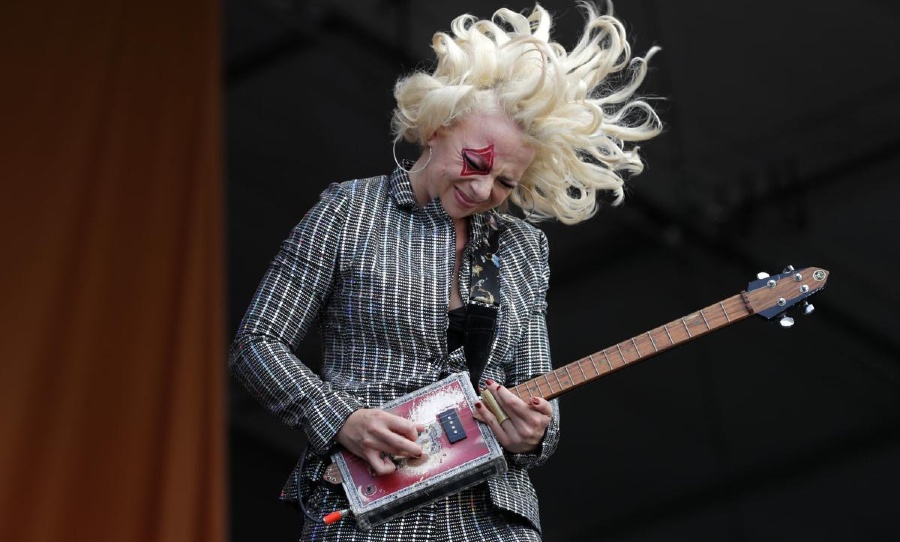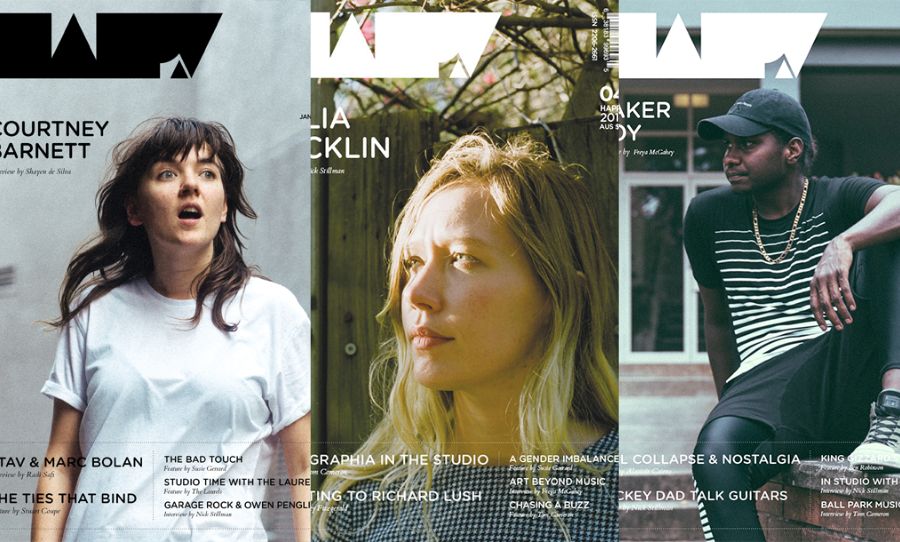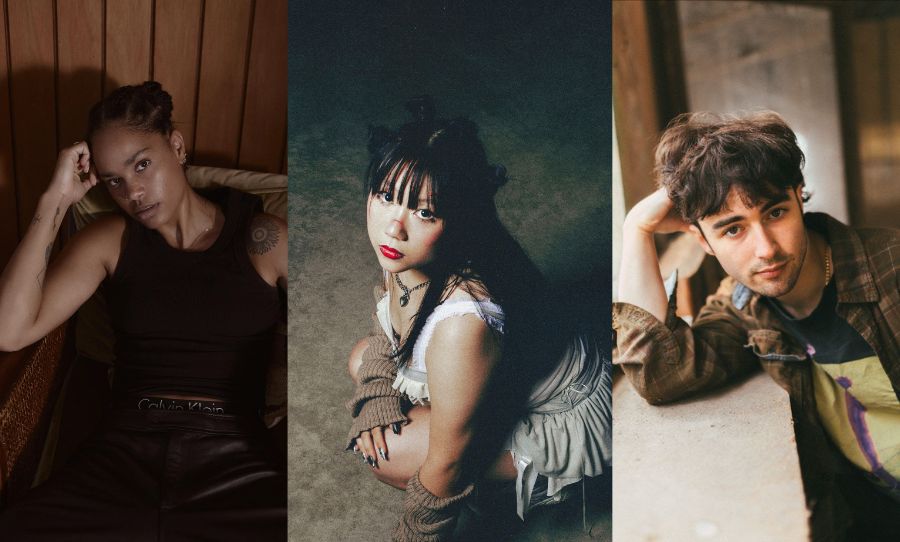The repertoire of Samantha Fish is eclectic as it is soulful. Read on as she chats her guitar collection, frequenting the iconic studios of the South and her honest approach to making records.
Samantha Fish was in the midst of a career-high when the coronavirus pandemic brought the live music industry to a grinding halt. She was in the middle of a European tour off the back of her latest record Kill or Be Kind. Her sixth album was released in the second half of 2019 and is still garnering some of the best reviews of her career.
After years of finding comfort in the studio environment and refining her songwriting with various collaborators, Fish created an album of incredibly diverse tracks of blues rockers, soul grooves, pop pleasers and some delicate ballads, too.
Spending the last few months in isolation, Fish hasn’t been able to tear it up on stage with her brand of raw, unhinged blues-rock. Slowly, tour dates are being added as the world opens up again. When we spoke, she had just finished up a songwriting session — using the time off to her advantage and gearing up for the next album.
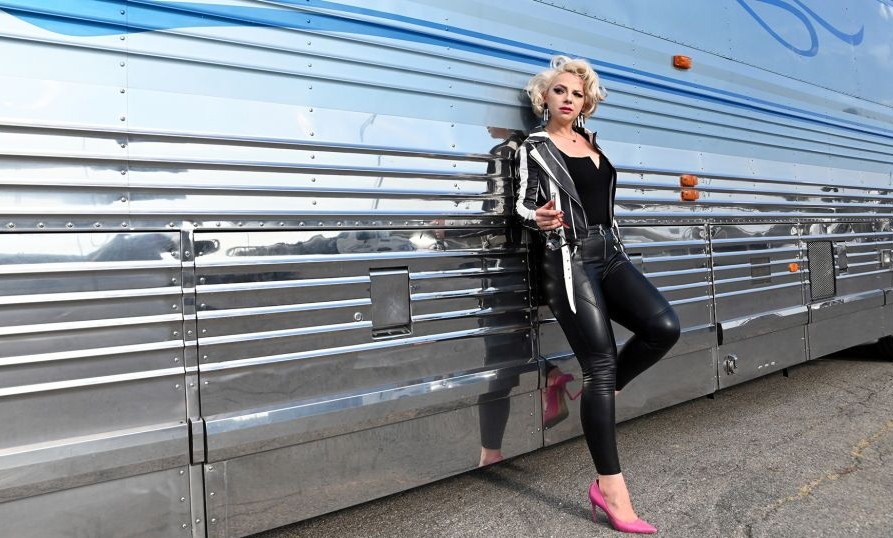
ENMORE AUDIO: You’ve recorded in a few different studios across your six albums. Belle of the West was recorded at Zebra Ranch Studios in Mississippi and your latest release Kill or Be Kind was recorded at Royal Studios in Memphis, as well as The Rhythm Shack and The Music Shed in New Orleans. Can you tell us about the ‘flavour’ of some of these studios and how they’ve influenced the tracks?
SAMANTHA: Well I really think location has a lot to do with even the vibe when you walk in. It really can help you colour the session in a certain way. I’m trying to think back to… even on my first record, Runaway, we did that in Berlin.
ENMORE AUDIO: Oh wow.
SAMANTHA: Yeah it was wild. When I listen to it now, I can feel how — off-kilter might be the wrong word — but I remember feeling completely foreign in a strange place, this was a completely new experience. When we went and did Wild Heart, we kind of went on a pilgrimage, so to speak. We started the record in Shreveport [Louisiana], we recorded some of it at the Zebra Ranch, like you said, and then Memphis is where we finished.
I really like recording albums in the South just because there’s such a steep vibe and you can really find these culturally rich studios that have so much of a story to tell and you can get lost in it while you’re there making your music. In particular, the last studio we did, Royal Studios in Memphis, that place has had everyone from Al Green to Ann Peebles to Bruno Mars!
ENMORE AUDIO: What a mix!
SAMANTHA: Yeah! And it’s got musical history artefacts in there like the microphone that Al Green sang all of his hits into is set up in the vocal booth, the Coca-Cola box he stomped on for — I think it’s [hums tune] I can’t remember the name… Here I Am Baby! And the Ann Peebles drum machine we used on Kill or Be Kind.
Sometimes when you’re in these rooms that have such a musical historically rich thing to them, it’s even more important and special when you’re in there – you just kind of get in the zone.
ENMORE AUDIO: Of course! Now, you’ve just touched on your first time in the studio. You were 22 when you released your first album, is that right?
SAMANTHA: I was 21 maybe, cos I was on tour when I was 22 and the record had just come out.
ENMORE AUDIO: What was your first time in the studio like and how has it changed now across six albums?
SAMANTHA: Well the first time I was in the studio was to do Girls with Guitars — we did that in October of 2010 leading up to our tour in 2011. And then I returned to that same studio to record Runaway (my first full-length studio album) with the same band because we had such good chemistry with Girls with Guitars.
Having that first softball, break-in to the studio with Girls with Guitars — I only had to front three songs and it was a collaborative effort and we had all three in there and feeling good about the vibe we had as a band. I feel like that definitely helped to kill some of the nerves when I went in for my album.
Actually, what the hell am I talking about? I was so nervous I got laryngitis and I couldn’t sing!
ENMORE AUDIO: Oh my God…
SAMANTHA: I was totally freakin’ nervous! But Girls with Guitars really helped break-in that experience for me a little bit. It’s all so weird because you’re used to doing things live — I’ve always considered myself a live act, we do so many shows a year. And when you put those headphones on and you hear your voice for the first time really close up with all the edges and everything, it kinda does your head in!
ENMORE AUDIO: Yeah, it’s quite intimidating.
SAMANTHA: Yeah, it’s a little intimidating and all of a sudden, you’re tight; your shoulders get tight and your neck gets tight and you’re not singing as freely as you do at the show where you’re relaxed and there’s this transfer of energy that happens between a crowd and yourself. So, it was challenging, and It took me years and years and years to finally get to a point where I felt comfortable in a studio setting.
ENMORE AUDIO: And so do you assume more of a production role now, or are you 100% focussed on performance and getting that take down?
SAMANTHA: Oh man! I probably drive every producer I have crazy because I get so excited about it and I’m like crawling on the console! I get excited because I hear things in my head, I’m like “this’ll be a cool part” and sometimes it’s overkill. And that’s why you have a producer who’s that unbiased filter to help you get where you want to go — and will help stop when you’ve gone too far.
But I like to get a little more hands-on now, I think back then — if we’re talking about my first album — I didn’t know what the hell I wanted to do. I was a baby and I wasn’t sure about how any of that stuff worked and so I was very shy. But now I’ve had a little more experience and I know a little more about where I wanna go.
ENMORE AUDIO: For sure. I was just listening to Kill or Be Kind again the other day and there are songs on the album like the title track and Love Letters that have got this real laid-back, in the pocket groove going on.
SAMANTHA: Yeah!
ENMORE AUDIO: Is that born out of jam sessions with the band? How did you develop the songs on that album?
SAMANTHA: Well we do everything live with the band as the core audio part of it because I really feel like you capture the energy in a moment. You get some momentum with a real band. A lot of times, the way that we perform songs for the studio is you run through it several times and then when you learn the song — you’ve gotta find the balance between “we just learnt the song and we’re not gonna screw up the changes” to “now we know it too well and we’re playing it robotically.”
There’s this perfect sweet spot where we all kind of don’t know what’s going on but we all kinda do, and you can find this perfect take that has the energy you’re looking for.
ENMORE AUDIO: I read that one of your influences was The Rolling Stones’ Sticky Fingers album.
SAMANTHA: Huge, huge influence!
ENMORE AUDIO: And there’s a lot of similar instrumentation of those songs on your new album including horns and keys alongside your rock rhythm section — and that’s all recorded live and together too!
SAMANTHA: Oh man, I don’t know how they did it! [Laughs] What I like about those albums and The Rolling Stones, in particular, you can hear the mistakes — if you’re being critical, you can find them. But they are such a good band and they play so well together that the mistakes almost sound so intentional and it becomes iconic, you know?
ENMORE AUDIO: Oh yeah!
SAMANTHA: I really like that about them because they use that looseness to their advantage and create iconic sounds and iconic tracks out of it. Whereas if they made that shit completely perfect it’d be boring! And it would be overwrought! And it wouldn’t be what it is, it wouldn’t be this legendary thing. So, what I pull from them is that you leave the edges in. It’s got a voice that way, it makes it unique.
ENMORE AUDIO: And when you’ve recorded with the band are all the tracks mixed in the same studio, or do you take them somewhere else?
SAMANTHA: It just depends. We’ve done it different ways, honestly. A lot of the time they send it off to a mix engineer — I’m not there with them. I might have my notes about it but a lot of the times I have to draw the line at some points because there are jobs that mix engineers are really good at.
I have no business at trying to be a mix engineer because I don’t know anything about that field. I know probably more than the average bear, but that’s not my job. I try to respect those lines, they’re there for a reason. I don’t need to be all over it.
You’ve gotta get people that know more about what they’re doing than you do and that’s how you get a good record. If I was doing it, shit would be way off [laughs]!
ENMORE AUDIO: [Laughs] So let’s get a bit more into your guitar work. How do you track your guitars in the studio? What amps do you use?
SAMANTHA: Well for the last record, I have a custom cabinet that we used a lot. It’s a combo but it’s got a 10 and a 12-inch speaker in there, that’s a Category 5 — that’s what the brand is. And I like that for clean rhythm tracks. But what we used on solos — the studio had this really old Fender Super that was just tweaked to perfection.
And I generally just stick to old tube amps. We’ll just bring in a collection of them and see what sounds best. For Chills and Fever, I played through a little teeny, tiny Supro for the entirety of the record — it was just the best tone! I really like small amps for the studio because you can really make them sound big and mean. And they just have the best tonal quality — you really can’t beat an old Supro in the studio, it just sounds amazing.

ENMORE AUDIO: I’ve gotta get me one! Have you picked up any go-to recording techniques along the way? Say, with the last album or going into the next one, do you know exactly how you want to set up and go?
SAMANTHA: I try to not get too comfortable with one way of doing things because I feel like you gotta challenge yourself as an artist. Every producer has a different way of doing something, so I try not to go in there with too many preconceived notions. If I feel like something’s way wrong or way off, then I’ll say something. But, to me, an album is such a great opportunity to grow.
Everybody there has something to offer, so if I come in and say “it has to be exactly like this and this way” then I feel like I’m not allowing the sound to be what it’s supposed to be as a growing thing for everybody involved.
I try not to come in with too many rules or restrictions. I mean, I like to play it live which I touched on a little bit before. I like getting the take all at once. I don’t like being in the isolation booth with my guitar trying to record the tracks while the drummer has already recorded his part. I like to do it at the same time because you catch some of these pocket things that maybe you wouldn’t catch if you’re over analysing it on the back end. Do you know what I mean?
ENMORE AUDIO: Absolutely, you’re capturing a real band performance.
SAMANTHA: Yeah, I like to do it that way but if I had to do it another way, it’s just a challenge, you know, and challenge accepted! We’re gonna make the best record no matter what we gotta do to get it!
ENMORE AUDIO: Nice, that’s the best attitude! So, tell me about your current pedalboard setup and how that has grown over time. What’s been behind the choices you’ve made in building it?
SAMANTHA: Well it’s constantly evolving and changing — and breaking and having to get rebuilt to be better and louder and stronger. My favourite pedal which is half broken, but I still use it because it’s rad and hard to find, is the Analogman King of Tone.
Mine’s actually an older version. I got it from a friend who got it from a friend, it’s been passed through the south-eastern guitarists of America to me, basically. So that’s my favourite pedal. Its’s half broken but I still use it every show. It’s just amazing.
And then I have JHS Mini Foot Fuzz which, if you really wanna push things over the top, you just hit that. I’ve got an MXR Carbon Copy Delay — kind of a classic, easy going. Kind of fun to fool with. A Super Shifter which is cool for fun dive bombs and weird tone effects. I’ve got, I’m trying to think what else, a Micro POG — you know those?
ENMORE AUDIO: Oh yeah, those are fun!
SAMANTHA: Yeah, if you wanna throw people way off, you can do that. I like effects that affect people! We gotta freak ‘em out, so I want something that’s really gonna shock ‘em when it comes on. But I’ve got some more delicate nuanced stuff, that’s kind of what I’m working with right now.
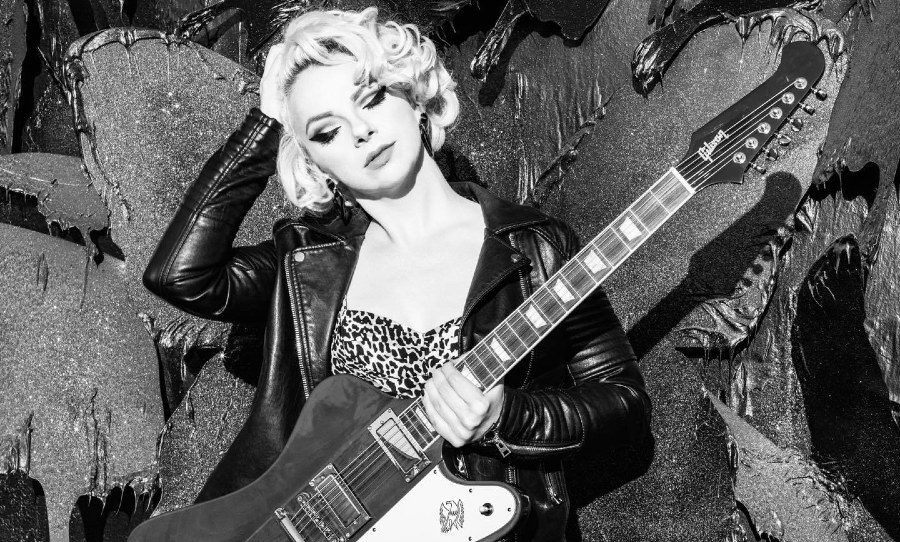
ENMORE AUDIO: Well you’ve got a very eclectic mix of guitars at your disposal. There’s your SG, the Jaguar that features on the cover of Kill or Be Kind and a really funky cigar box guitar. Can you tell us about your collection and how you go about deciding which guitar is best for each song? Is there a trial process or do you just pick one up and go for it?
SAMANTHA: You do enough shows and you figure out the ones that feel best. I do have a guitar that I use for slide but I don’t always bring it with me, so I’m left to my own devices to figure out which other guitar is gonna sound decent with slide.
Sometimes I’ll mix it up throughout a tour, I’ll switch the guitars out. My Gibson SG is probably my most relied upon guitar for the bulk of the show. I feel like it’s really diverse and you can get a versatile range of tone out of it and I can play slide on it.
But a lot of times, what causes me to pick up different instruments is tunings. You don’t wanna be sitting there awkwardly drop tuning a guitar while everybody is staring at you — and I don’t have any good jokes! It just sucks the air out of the room. So, I have a bunch of different guitars with different tunings, whatever the show may require.
Lately, the SG is probably my favourite. I really like my Gibson Firebird, it’s pretty rad. My Jaguars are really cool. I got one of the new Vintera series which is a little more aggressive than the one that you see on the cover of Kill or Be Kind. That one’s more jangly, like R ‘n’ B-ish, like a light touch kind of guitar which I dig for certain songs. There’s a Taylor Koa Acoustic and, of course, the cigar box guitar which just sounds freaky and everybody loves it!
ENMORE AUDIO: What’s the story behind that one?
SAMANTHA: I started playing that back in 2013. I picked it up on a street corner in Helena, Arkansas. We were playing a festival — and years before, rewind, I was 17 years old and that was the first festival I ever went to. And I saw all these guys playing these cigar box guitars and I just thought they were the most unique, weird, raw sounding guitars.
I was like “wow that’s cool”. And so, years later, we come back to play it and I saw somebody selling it, I picked one up just for, I don’t know, nostalgia sake, and plugged it in and people lost their minds. It’s a really aggressive-sounding guitar and I think it surprises people cos it’s so small. I do a lot of North Mississippi, rock ‘n’ roll type blues on it.
ENMORE AUDIO: It’s a great little beast! In a live performance of Kill or Be Kind you make a sneaky guitar swap for an extended slide solo leading straight into Watch it Die. Your live sets are where you really let loose, what is your process in translating your recordings for the stage? They’re already tracked in a live environment, what else goes into putting together the live shows?
SAMANTHA: That’s like a huge pain in the ass because sometimes I lay down several different guitar takes, different layers that build out the drama and the dynamic of the song. But then I get really attached to certain parts of the song that I want to recreate live but can’t possibly because I’m the only guitar player.
So, you end up seeing me do a lot of guitar switches mid-song. And that’s usually because, if you’re talking about Watch it Die, that song is in open C on the record, we do it in an open D, then I switch to a standard tuned guitar in the middle of the set to get my solo across. Which is just kind of cheating, I guess. But, you gotta do that a lot on the stage you know [laughs]!
I mess around with different effects pedals to try and mimic certain things from the album. But when all else fails you’ve got other people on stage with you who can help you recreate some of those sounds. My drummer had a pad so he could sample some things here and there.
Like on Dream Girl there’s a chain dropping on a loop and so he takes a chain and drops it on his floor tom or on a piece of wood on top of his floor tom so we could recreate as much of the sound as possible.
The truth is live things sort of become something else. And I think people expect that; they like the evolution of the songs. And I like to do that too because you can really cater things around to a new way.
ENMORE AUDIO: Your guitar playing incorporates a few different styles, you use slide and have your own fingerpicking technique. But you started as a drummer [Samantha laughs]. How has that influenced your guitar playing?
SAMANTHA: I always tell people that if you’re into music and you want to play an instrument, start with the drums. That’s just gonna help you get that innate sense of rhythm and it’s so important to be able to make something danceable. And I feel that the drums just helps reaffirm and establish a sense of rhythm so that when I started playing guitar and singing I already had that in the back of my head. It would have been a little bit of a hurdle to jump through, but it helped. It was a little bit of a short cut.
ENMORE AUDIO: Speaking of playing guitar and singing, how do you develop your vocal melodies? Are they influenced by your guitar parts? Because I listen to some of the stuff you’re doing on guitar while you’re singing and I’m telling you I don’t even think I can co-ordinate a lot of that sort of stuff!
SAMANTHA: Sometimes I overshoot my own ability and I just have to learn how to do it [laughs]! You come up with a cool vocal part independent of you playing the guitar and you gotta learn how to do ‘em both together. I’ve been in that situation plenty of times. I play off of my vocal melody a lot with the guitar, especially when you’re talking about soloing.
I think that if you have a strong melody, it can be a motif throughout the song you can call back to and I try and mimic it sometimes with my guitar solos. Not so much the other way around, I guess it’s situational, but I’ll try and play off my vocals sometimes with the guitar and find cool call and response type things.
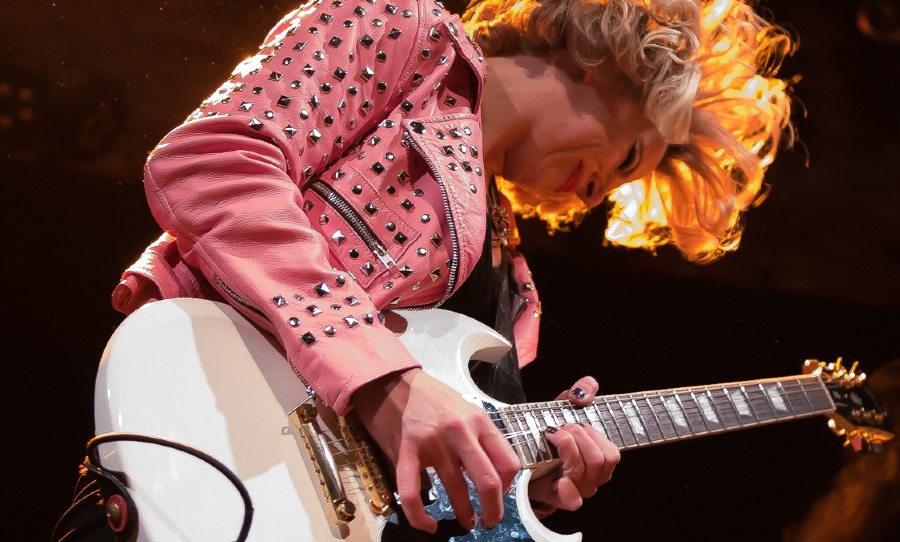
ENMORE AUDIO: You worked with a few different collaborators and musicians like Jim McCormick (Keith Urban, Harry Connick Jr), Eric McFadden and Katie Pearlman. How do you approach working with them and what sort of influences do they bring to the music?
SAMANTHA: I love co-writing. I’ve written with countless songwriters and I really like collaborating at that stage, that inception stage because writing lyrics… it comes and goes. Sometimes it flows really easily, other times it can be really difficult. And putting songs together, there’s no one way to do it. You can start with a hook, you can start with a melody, you can start with a cool guitar riff. Maybe you have a book of poetry you want to put into song form.
Every time you work with another songwriter, at least for me, I feel like I learn something new because everybody has a different approach to making it happen. And I did that, and everybody has a different goal that they’re trying to achieve and I’ve had songwriting sessions that didn’t really work. It’s trial and error sometimes and you don’t produce anything. But most of the time you learn something, even if you don’t get a great song out of it — which is the aim. Every single time you learn something, which is cool too.
ENMORE AUDIO: Very cool. And I guess to wrap things up, you said you’ve been doing a lot of writing, are the wheels in motion for album number seven? Have you got any plans on where you wanna record that?
SAMANTHA: Come on, you know the wheels are rolling! I’ve had all this time off, I gotta do something with it so yeah, the wheels are rolling! I’ve been writing a lot. New collaborations are happening via zoom – which is the weirdest way to write.
ENMORE AUDIO: Oh wow, okay. That must be! How does that work?
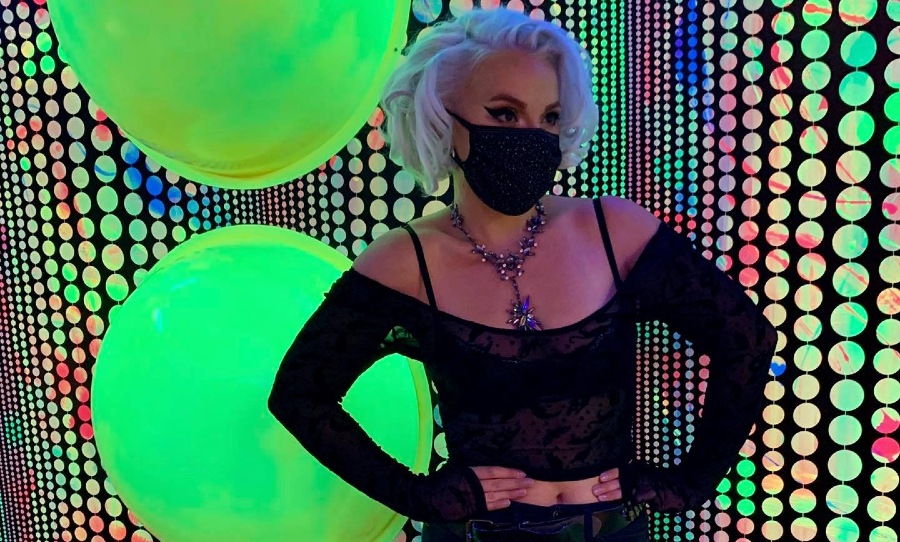
SAMANTHA: We had to figure out, “Well, how do we still write together?” And we can’t really go anywhere or see each other. Well, we have technology to help us with that. I’ve been collaborating in that sense, gearing up for the next record.
As for the whens and the hows and the whos? I don’t wanna give too much away, I don’t even know that yet [laughs]! It’s still being shaped but I’m excited about it and I’m looking forward to hopefully having some new music out in the first half of next year.
ENMORE AUDIO: And I know you’ve got some tour dates lined up so we’re hoping that you come down to Australia at some point when all this is over!
SAMANTHA: Oh man, I can’t wait to come see you guys!
Samantha Fish is available on all streaming platforms. To find out more, visit her website.
